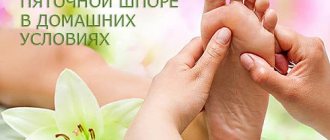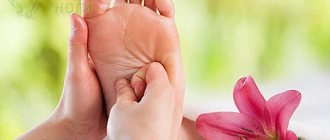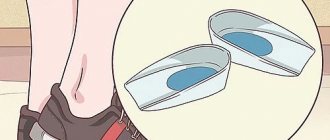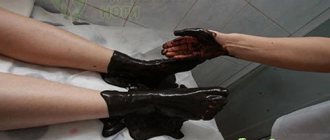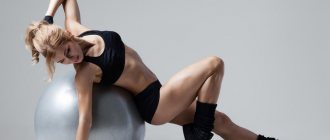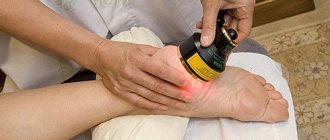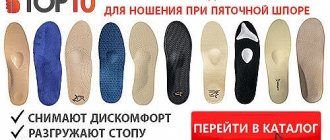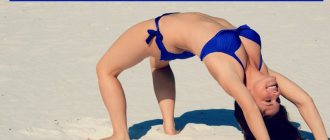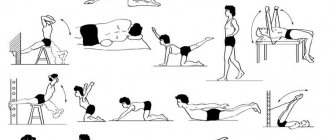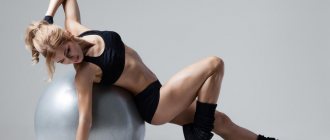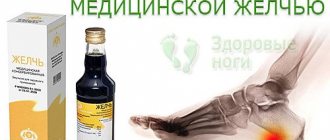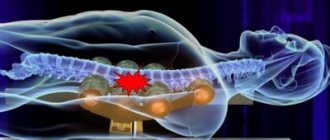Heel spur (plantar fasciitis) is a disease characterized by acute pain in the heel, comparable to the pain from stepping on a sharp pebble, which sharply increases with exercise. The process of inflammation at the site of attachment of the plantar fascia and tendons to the heel bone leads to the formation of a “spur.” There are many factors leading to its development - from wearing the wrong shoes to being overweight.
Diagnosis and treatment are prescribed by a traumatologist based on a survey, physical examination and necessary research. The rehabilitation exercise technique presented here is aimed at eliminating plantar stress in the foot and restoring muscle function. It can become a powerful tool in the treatment of heel spurs in combination with other therapeutic measures.
If necessary and in agreement with your doctor, you can undergo 2-3 muscle relaxation sessions with a specialist. In my opinion, effective treatment for heel spurs must be a comprehensive approach.
Clothes should be loose, it is advisable to remove shoes. Perform all exercises (especially the first days) smoothly and gradually. Remember the important principle: “Endure mild pain, do not allow severe pain.”
Do these exercises every day for at least 2 weeks.
Plantar massage while sitting
Sitting on a chair, place the shin of the leg you are working on on your other knee.
Using the same hand, extend your fingers towards your shin until you feel a stretch in the sole. With your other hand, massage the bottom of your foot, moving from your heel to your toes. Duration: 3-5 minutes. After all the stretching exercises are done, move on to strengthening the muscles.
How does gymnastics help with heel spurs?
Physical therapy for heel spurs is based on training the heel fascia. With constant exercise, it becomes elastic and strong, minimally susceptible to micro-tears when exposed to salt deposits.
Gymnastics also helps to stretch the muscles of the feet and legs, due to which the longitudinal dimensions of the fascia increase.
The main advantage of gymnastics is the absence of side effects and a minimum of contraindications.
To enhance the positive result, it is necessary to unload the heel by wearing orthopedic insoles with spurs, protecting the fascia from impact load.
If you do gymnastics regularly, then exercises for heel spurs give the following results:
- strengthens connective tissues and tendons, preventing their damage;
- accelerates the regeneration of injured heel tissue;
- prevents salt deposition and build-up;
- improves blood supply to the feet;
- makes the heel fascia firm and elastic.
When assessing the effectiveness of exercise therapy, it is necessary to answer the question: is it possible to walk a lot with a heel spur? In this case, physical therapy replaces walking, running and exercises that load the legs, which are contraindicated for spurs. Contraindications to physical exercise are open wounds of the feet and some forms of varicose veins.
Therapeutic gymnastics for heel spurs: Bubnovsky exercises
Russian professor Sergei Bubnovsky, specializing in pathologies of the musculoskeletal system and orthopedics, has developed a special complex for people with problems with the longitudinal arch of the foot and weak calcaneal fascia.
Considering that the goal of exercise therapy for heel spurs is to strengthen the fascia, the Bubnovsky complex is also suitable for those suffering from heel spurs.
If you have a painful heel spur, Bubnovsky's physical exercises can be performed while lying in bed immediately after waking up.
The complex includes the following exercises:
- Lie on your back, arms along your body, and feet shoulder-width apart. Stretch both big toes up and bend towards you. Press your heels into the surface.
- Lie down as in exercise 1 and try to spread your thumbs as wide as possible.
- Raise your leg and rotate your foot inward/outward.
- Bend and smoothly straighten the phalanges of your toes.
- Try to clench your foot into a fist and slowly straighten it.
You will spend no more than 5-10 minutes on the whole complex, but it will help get rid of the pain that very often torments patients in the morning.
The effectiveness of physical education for heel spurs
Regardless of how a heel spur is treated, exercise therapy will bring tangible benefits. However, you should not expect that gymnastics will rid you of spurs after just a few sessions.
To get results, you need to train daily, gradually increasing the load. It is also worth understanding that exercise therapy cannot replace drug treatment and physiotherapy for heel spurs.
The patient should also be aware of the need to unload the heel while walking. This can be achieved using a Strutz instep support and orthopedic heel pads.
When to do foot exercises for heel spurs?
Taking into account the peculiarities of the formation of heel spurs and the increase in pain in the morning, we can conclude that the optimal time for doing gymnastics is the morning immediately after waking up.
If you use a Strasbourg orthopedic sock, then in the morning the fascia will be in a stretched state. In this case, exercises will help lengthen and restore it.
In the absence of a Strasbourg sock, the effect of the exercises will be less, because The heel fascia is in a compressed state. In this case, exercise will not only strengthen the tissues of the feet, but will also reduce morning pain.
After finishing gymnastics, it is important not to subject the heel to excessive stress. For this purpose, special orthopedic heel pads are used, suitable for any shoe.
Exercises for heel spurs must be performed regularly. You will feel the first results after 2-4 months. In combination with other methods of treating heel spurs at home, such as massage and medicinal baths, gymnastics will give the best results.
Exercise therapy for heel spurs: basic rules
If you have a heel spur, massage and exercises will only be beneficial if you follow simple rules:
- All exercises must be performed correctly, without rushing. Do not allow sudden movements that can injure the fascia of the heel and arches of the feet.
- During gymnastics, a person may experience mild discomfort - a nagging pain associated with stretching of the connective tissue. At the same time, doing exercises and enduring severe pain is strictly prohibited!
- The load on the feet must be increased gradually: on the first day, do the exercise 1-3 times, on the second - 3-5, gradually increasing their duration.
- Therapeutic exercises for heel spurs should begin with warm-up stretching. The pace of the warm-up is slow with a gradual increase in speed.
- Complete the exercise with stretching and massage.
Exercises to treat heel spurs
The basic complex, recommended for heel spurs, includes 6 simple exercises:
Exercise No. 1 or Warm-up
Place your feet one after the other, as if you were walking along a very narrow bridge. Place your palms on the wall. Start slowly doing squats to the point where your shins and thighs are perpendicular to each other.
This exercise perfectly stretches the muscle tissue of the feet and legs, preparing them for the main load.
Important! During a squat, you need to freeze at the bottom point for 5-10 seconds. Gradually this time can be increased to 30-50 seconds.
Exercise No. 2
Stand on a step, a high threshold (you can also use a block or a stack of books). The heels should be hanging in the air and the rest of the foot should be on the surface. With your palms outstretched, lean on the wall and slowly lean towards the wall, feeling the tension in your ankle muscles. At the lowest point, freeze for 5-20 seconds.
Exercise #3
Take a rolling pin, ball, plastic pipe or water bottle, place it under your foot and roll from toes to heel. Rolling a bottle for heel spurs is very useful for those who experience morning pain. This is the main exercise of the complex, which has an excellent healing effect.
Exercise #4
We scatter small objects on the mat: pebbles, pencils, peas, coins, etc. Using your feet, you need to collect as many different objects as possible.
This exercise perfectly strengthens the heel fascia and increases its elasticity. If you have difficulty picking up items while standing, you can sit on a comfortable chair.
Exercise #5
We sit on a chair and place our right foot on the knee of our left leg. We take the toes of the right foot with our hands and pull them towards ourselves, while turning the foot outward. Perform for 2-3 minutes. then change legs. This exercise helps to stretch the arch of the foot as much as possible.
Exercise No. 6 or Cool down
There are 2 ways to cool down:
- standing using a jump rope;
- sitting with the help of a tape.
We pass the rope or ribbon from below under the feet and pull it up, trying to stretch the feet as much as possible. In this case, the socks must be pulled up. If you have a heel spur, foot gymnastics should end with this exercise.
Walking barefoot on uneven surfaces helps with spurs. Excellent results are achieved by using special massage mats with different textures. When exercising on a mat, you need to rise on your toes, then carefully transfer your weight to your heel.
What to do after charging?
After gymnastics, it is recommended to take a foot bath and have a relaxing massage. Folk remedies for heel spurs advise taking baths with sea salt, iodine, honey, and also based on medicinal herbs.
After the bath, you need to apply Pyatkashpor cream containing medical bile to your feet. Creams from the Pyatkashpor line soften the skin of the heels and help the bone spine to dissolve.
You can do a relaxing foot massage for heel spurs yourself. Massage movements consist of stroking, light tapping and pinching. The main goal of the procedure is to relax the nerve endings of the fascia and normalize blood circulation in the feet.
To fix the heel fascia in the correct position during the day, you can use kinesio tape for heel spurs, and at night - a Strasbourg sock.
